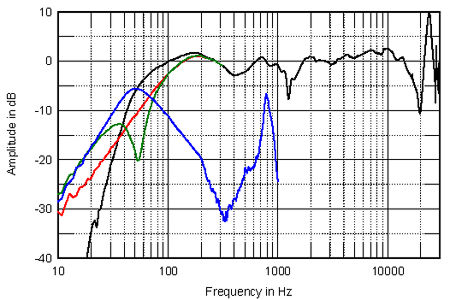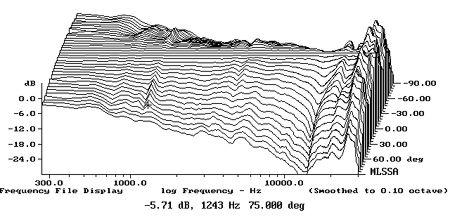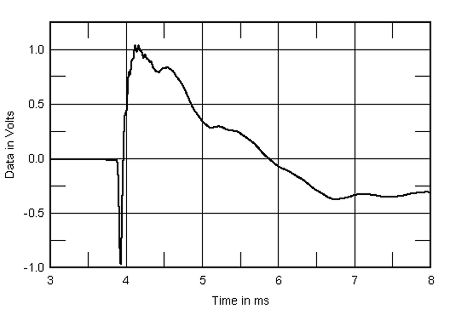| Columns Retired Columns & Blogs |
Amphion Helium2 loudspeaker Measurements
Sidebar 3: Measurements
As is often the case with minimonitors, the Amphion Helium2 is a little below average when it comes to voltage sensitivity, at an estimated 85.5dB(B)/2.83V/m. This is slightly but inconsequentially below the specified 86dB. However, its plot of impedance magnitude and electrical phase angle (fig.1) reveals the speaker to be very easy to drive, the impedance remaining above 8 ohms for almost the entire audioband. This graph was taken with the reflex port open; the saddle centered on 54Hz in the magnitude trace suggests that this is the tuning frequency of the rear-facing port. However, foam plugs were supplied with the speakers, presumably for modifying the bass alignment to work as a sealed box. Inserting a foam plug produced an impedance plot with a single peak in the bass at 78Hz (fig.2), which implies that the little Amphion will have a lightweight bass when used in this manner. However, this alignment will work well if the speaker needs to be used in close proximity to the wall behind, the boundary reinforcement usefully extending the low frequencies.
Although they are difficult to see at the size fig.1 is printed in the magazine, there are a few wrinkles in the impedance traces that suggest the presence of resonances of various kinds. That around 25kHz will be due to the metal-dome tweeter's primary resonance, which is high enough in frequency not to be an issue with respect to sound quality. However, the slight glitches between 400Hz and 600Hz might be due to enclosure resonances. Investigating the cabinet's vibrational behavior with an accelerometer revealed a strong resonant mode to be present on the sidewall (fig.3). This might— might —be the source of the "hootiness" Bob Reina noted in his auditioning, though it is difficult indeed to predict the effect of cabinet resonances on sound quality.

Fig.1 Amphion Helium2, electrical impedance (solid) and phase (dashed) with port open (2 ohms/vertical div.).

Fig.2 Amphion Helium2, electrical impedance (solid) and phase (dashed) with port sealed by foam plug (2 ohms/vertical div.).

Fig.3 Amphion Helium2, cumulative spectral-decay plot calculated from the output of an accelerometer fastened to the cabinet's side panel (MLS driving voltage to speaker, 7.55V; measurement bandwidth, 2kHz).
Turning to the acoustic outputs of the drive-units, to the left-hand side of fig.4 are shown the lower-frequency responses of the woofer when reflex-loaded (green trace), the woofer when sealed-box–loaded (red), and the port (blue), all measured in the nearfield. The sealed-box woofer rolls off below 125Hz or so, but with a relatively slow, second-order slope, as expected. The reflex-loaded woofer has the expected notch in its output at the port's tuning frequency of 54Hz, when the back pressure from the port resonance holds the woofer cone still. All the acoustic output radiates from the port at this frequency, demonstrated in fig.4 by the broad peak in the blue trace centered on 54Hz. However, there is a large peak at 800Hz in the port's output, implying the existence of some sort of air-space resonance at this frequency. The port faces away from the listener, which will work against this resonance having an audible effect. However, it is also possible that it contributes to Bob Reina's feeling that the speaker was a bit "hooty."

Fig.4 Amphion Helium2, anechoic response on tweeter axis at 50", averaged across 30 degrees horizontal window and corrected for microphone response, with the nearfield woofer (green) and port (blue) responses plotted below 350Hz and 1kHz, respectively, as well as their complex sum (black), taking into account acoustic phase and distance from the nominal farfield point, plotted below 300Hz. The red trace shows the nearfield response of the woofer with the port blocked with the supplied foam plug.
The black trace below 300Hz in fig.4 shows the sum of the woofer and port outputs, taking into account acoustic phase and distance from the nominal farfield point. The rise in the upper bass is an artifact of the nearfield measurement technique and should be ignored. The Helium2 appears to offer a textbook reflex alignment. To the right of fig.4 is shown the speaker's farfield quasi-anechoic response, averaged across a 30-degree horizontal window on the tweeter axis. The region covered by the tweeter is slightly elevated, but not by enough to make the Amphion sound bright. The suckout between 1kHz and 2kHz is problematic but might not be a subjective problem if specific to this listening axis.
Fig.5, which shows the Helium2's vertical radiation pattern, normalized to the tweeter-axis response, reveals that this suckout does fill in both above and below this axis. However, there is also a suckout at the crossover frequency evident above the tweeter axis, so the speaker is best auditioned on high rather than low stands. In the lateral plane (fig.6), the Amphion's dispersion is wide and even below 10kHz, which correlates with stable, well-defined stereo imaging. In the top audio octave, however, the waveguide results in a more restricted dispersion than would otherwise be the case for a 1" tweeter, which might make the speaker sound a little lacking in "air" in large or acoustically dead rooms.

Fig.5 Amphion Helium2, vertical response family at 50", normalized to response on tweeter axis, from back to front: differences in response 45 degrees–5 degrees above axis, reference response, differences in response 5 degrees–45 degrees below axis.

Fig.6 Amphion Helium2, lateral response family at 50", normalized to response on tweeter axis, from back to front: differences in response 90 degrees–5 degrees off-axis, reference response, differences in response 5 degrees–90 degrees off-axis.
The Helium2's step response (fig.7) reveals that the tweeter is connected in inverted acoustic polarity, the woofer in positive polarity. However, the setting back of the HF driver within the waveguide means that the positive-going overshoot of the tweeter's step coincides with the initial rise of the woofer's step. Note the lower-frequency undulations in the tail of the speaker's step. These correlate with a ridge of delayed energy in the cumulative spectral-decay plot (fig.8)—curiously, at the frequency of the on-axis notch. There is also a ridge at 4.3kHz, but this is low enough in level that it can be ignored. Apart from those two things, this waterfall plot is superbly clean.

Fig.7 Amphion Helium2, step response on tweeter axis at 50" (5ms time window, 30kHz bandwidth).

Fig.8 Amphion Helium2, cumulative spectral-decay plot at 50" (0.15ms risetime).
In many ways, the Amphion Helium2 offers superb measured performance. But I admit to being a little perturbed by the midrange resonant problems in the port's output.— John Atkinson
- Log in or register to post comments




































